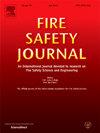Impact of temperature on firefighter task performance and subjective workload in VR simulations
IF 3.4
3区 工程技术
Q2 ENGINEERING, CIVIL
引用次数: 0
Abstract
This study explores the impact of elevated temperatures on firefighters' physiological responses, subjective workload, and task performance during emergency scenarios using a virtual reality (VR) system. Thirty firefighters completed VR -based tasks in both room-temperature and high -temperature conditions while wearing both real and virtual firefighting gear, allowing for the evaluation of task load, water-flame distance (WFD), task times, and response time (RT). Results demonstrated that high-temperature environments significantly increased multidimensional workload, particularly in performance and effort. Workload was strongly correlated with reduced WFD (r = 0.87, P < 0.05) and physiological strain, such as increased heart rate and skin temperature (r = 0.79, P < 0.05). Task times were extended by 23 %, and fire extinguishing time (FET) was prolonged by 43 % in high heat, largely due to decrease in fire suppression accuracy and increased workload. However, reaction times for fire detection remained consistent, likely due to instinctual visual cue responses. These findings highlight the necessity of adapting firefighter training protocols to address the heightened cognitive and physiological demands posed by high-temperature environments.
VR模拟中温度对消防员任务绩效和主观工作量的影响
本研究利用虚拟现实(VR)系统探讨了高温对紧急情况下消防员生理反应、主观工作量和任务绩效的影响。30名消防员穿着真实和虚拟的消防装备,在室温和高温条件下完成基于VR的任务,从而评估任务负荷、水火距离(WFD)、任务时间和响应时间(RT)。结果表明,高温环境显著增加了多维工作量,特别是在性能和工作量方面。工作负荷与WFD降低密切相关(r = 0.87, P <;0.05)和生理应变,如心率和皮肤温度升高(r = 0.79, P <;0.05)。在高温下,任务时间延长了23%,灭火时间(FET)延长了43%,主要是由于灭火精度的降低和工作量的增加。然而,火灾探测的反应时间保持一致,可能是由于本能的视觉线索反应。这些发现强调了调整消防员训练方案的必要性,以解决高温环境带来的更高的认知和生理需求。
本文章由计算机程序翻译,如有差异,请以英文原文为准。
求助全文
约1分钟内获得全文
求助全文
来源期刊

Fire Safety Journal
工程技术-材料科学:综合
CiteScore
5.70
自引率
9.70%
发文量
153
审稿时长
60 days
期刊介绍:
Fire Safety Journal is the leading publication dealing with all aspects of fire safety engineering. Its scope is purposefully wide, as it is deemed important to encourage papers from all sources within this multidisciplinary subject, thus providing a forum for its further development as a distinct engineering discipline. This is an essential step towards gaining a status equal to that enjoyed by the other engineering disciplines.
 求助内容:
求助内容: 应助结果提醒方式:
应助结果提醒方式:


